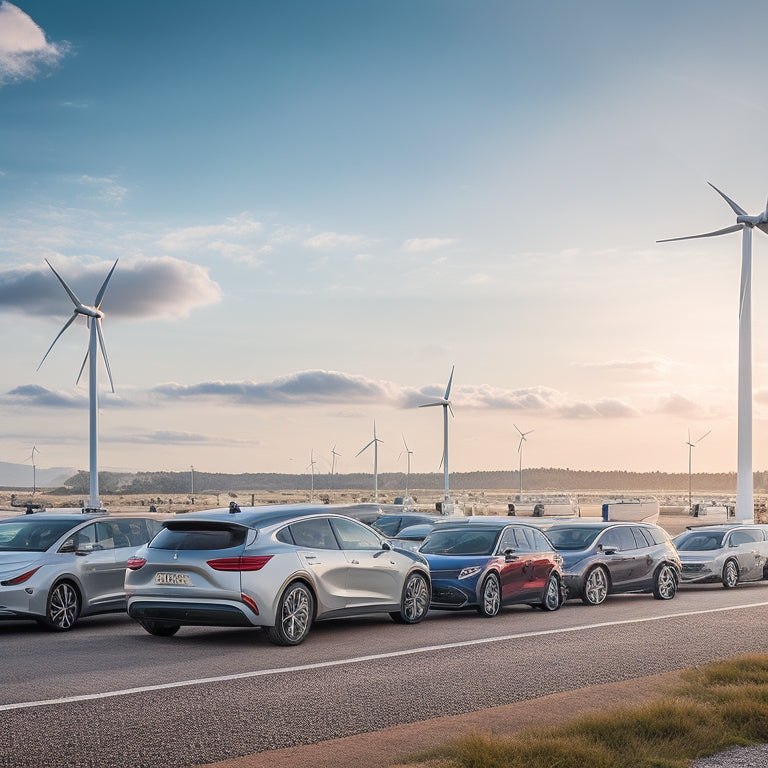
Eco-Friendly EV Charging Solutions for Fleets
Share
By adopting eco-friendly EV charging solutions, you can reduce your fleet's carbon footprint by up to 50% while also lowering operating costs and taking advantage of government incentives for sustainable practices. You can leverage renewable energy sources, like solar panels, to reduce reliance on the grid and minimize emissions. Implementing sustainable commercial vehicle charging practices and investing in energy storage systems can further optimize energy efficiency. As you explore eco-friendly solutions, you'll uncover opportunities to future-proof your fleet operations and stay ahead of the curve in sustainable transportation solutions.
Key Takeaways
• Invest in renewable energy sources like solar panels to reduce reliance on the grid and carbon footprint for EV charging.
• Implement carbon offset strategies, such as carbon credits and renewable energy certificates, to neutralize emissions.
• Adopt sustainable charging practices, including the use of energy storage systems, to minimize environmental footprint and reduce energy consumption.
• Design EV charging stations with modular, organized, and efficient systems to maximize charging speed and minimize downtime.
• Assess fleet readiness and develop a tailored electrification strategy to support the shift to electric vehicles and sustainable transportation solutions.
Renewable Energy for EV Charging
By leveraging renewable energy sources, you can greatly reduce your fleet's carbon footprint and operating costs, especially when paired with strategic EV charging solutions.
As a fleet operator, you can tap into government incentives designed to encourage sustainable practices. For instance, the federal government offers tax credits for businesses that invest in renewable energy infrastructure.
Additionally, engaging with your local community can help you identify opportunities for collaboration and education. By involving your community, you can raise awareness about the benefits of renewable energy and EV charging, fostering a positive reputation for your business.
Solar Panel Installation Benefits
As you consider solar panel installation for your fleet's EV charging needs, you'll want to tap into the benefits of a renewable energy source that reduces your reliance on the grid.
By harnessing the power of the sun, you'll not only shrink your carbon footprint but also enjoy significant energy cost savings over time.
With solar panels, you'll be locking in a fixed energy rate, shielding your fleet from volatile electricity prices and future-proofing your operations.
Renewable Energy Source
You can greatly reduce your fleet's carbon footprint by harnessing the power of solar energy, which can be easily integrated into your EV charging infrastructure through solar panel installations. This not only benefits the environment but also provides you with Energy Independence, reducing your reliance on non-renewable energy sources.
By installing solar panels, you'll be able to:
-
Reduce greenhouse gas emissions: Lower your fleet's carbon footprint and contribute to a cleaner environment.
-
Increase energy self-sufficiency: Generate your own clean energy and reduce your reliance on the grid.
-
Enhance community engagement: Showcase your commitment to sustainability and contribute to a cleaner, healthier community.
- Future-proof your operations: Stay ahead of the curve with a sustainable energy solution that's ready for the future.
Energy Cost Savings
Installing solar panels to power your EV charging infrastructure can greatly reduce your energy costs, with some fleets experiencing savings of up to 50% on their energy bills. By harnessing renewable energy, you'll reduce your reliance on the grid and lower your peak demand charges. This is especially important during peak hours when energy prices are highest.
Through load management, you can optimize your energy usage and flatten your peak demand, resulting in significant cost savings. Additionally, peak shaving strategies can help you avoid high-demand charges by shifting non-essential loads to off-peak hours.
Reducing Carbon Footprint Strategies
As you shift your fleet to electric vehicles, you're already taking a significant step towards reducing your carbon footprint. Now, it's time to explore additional strategies to further minimize your environmental impact.
Carbon Offset Strategies
By investing in carbon offset strategies, fleet operators can effectively neutralize their Scope 1 emissions and reduce their environmental impact. You can take control of your fleet's carbon footprint by adopting offsetting methods.
Here are some strategies worth exploring:
-
Carbon credits: Purchase credits from projects that reduce greenhouse gas emissions, such as wind farms or reforestation projects.
-
Emission trading: Participate in cap-and-trade systems, where you buy and sell emission allowances to stay within your allocated limit.
-
Renewable energy certificates: Invest in renewable energy projects, like solar or wind power, to offset your fleet's energy consumption.
- Sustainable land-use projects: Support projects that promote sustainable land use, such as reforestation or habitat restoration.
Fleet Emission Reduction
Reducing your fleet's carbon footprint requires a multi-faceted approach that incorporates a range of strategies to minimize emissions and optimize energy efficiency. You'll need to set clear emission targets and regularly monitor fleet performance to identify areas for improvement.
By analyzing your fleet's data, you can pinpoint opportunities to reduce fuel consumption, idle time, and energy waste. Implementing efficient route optimization, driver training programs, and regular vehicle maintenance can also help you reach your emission targets.
Sustainable Energy Sources
You'll need to incorporate sustainable energy sources into your fleet's operations to further reduce your carbon footprint. This is essential to achieving your eco-friendly goals.
To get started, consider the following options:
-
Wind Farms: Utilize wind energy to power your EV charging stations, reducing reliance on fossil fuels and lowering emissions.
-
Geothermal Power: Harness the earth's natural heat to generate electricity, providing a clean and sustainable energy source for your fleet.
-
Solar Energy: Install solar panels to power your charging infrastructure, taking advantage of renewable energy and reducing your carbon footprint.
- Hydroelectric Power: Leverage hydroelectric energy to fuel your EV charging stations, minimizing your environmental impact.
Sustainable Commercial Vehicle Charging
As you shift your commercial fleet to electric vehicles, integrating sustainable charging practices is essential to minimize your environmental footprint and optimize operational efficiency. This involves more than just installing charging stations; it requires a holistic approach to fleet management and vehicle maintenance.
Here's a breakdown of the benefits of sustainable commercial vehicle charging:
| Aspect | Sustainable Charging | Traditional Charging |
|---|---|---|
| Energy Source | Renewable energy sources | Non-renewable energy sources |
| Emissions | Reduced greenhouse gas emissions | Higher greenhouse gas emissions |
| Maintenance | Extended vehicle lifespan | Increased maintenance needs |
| Cost | Lower operational costs | Higher operational costs |
| Scalability | Easy to scale up or down | Difficult to scale up or down |
Energy Storage System Advantages
By integrating energy storage systems into your fleet's charging infrastructure, you can access additional benefits that further reduce your environmental impact and operating costs. Energy storage systems can help optimize your fleet's energy usage, reducing strain on the grid and lowering your energy bills.
Here are some key advantages of energy storage systems for your fleet:
-
Extended Battery Life: Energy storage systems can reduce the strain on your fleet's batteries, extending their lifespan and reducing replacement costs.
-
System Integration: Energy storage systems can be seamlessly integrated with your existing charging infrastructure, minimizing downtime and maximizing efficiency.
-
Peak Shaving: Energy storage systems can help reduce peak energy consumption, lowering your energy bills and reducing your environmental impact.
- Backup Power: Energy storage systems can provide backup power in the event of an outage, ensuring your fleet remains operational even when the grid is down.
Grid Resilience and Reliability
Incorporating energy storage systems into your fleet's charging infrastructure helps guarantee grid resilience and reliability, reducing the risk of power outages and brownouts that can bring your operations to a halt. By stabilizing the grid, you establish a consistent power supply, which is vital for maintaining fleet operations.
| Grid Impact | Energy Storage Benefits |
|---|---|
| Power Quality | Reduces voltage fluctuations, ensuring stable power supply |
| Grid Congestion | Offloads peak demand, reducing strain on the grid |
| Peak Demand | Shifts energy usage to off-peak hours, reducing strain on the grid |
Electric Vehicle Charging Station Design
You'll need to meticulously design your electric vehicle charging station to guarantee it can support your fleet's unique needs and maximize charging efficiency. A well-designed station will minimize downtime, reduce energy waste, and optimize your fleet's performance.
Here are some key considerations for your station architecture:
-
Station Architecture: A modular design allows for easy expansion and maintenance.
-
Cable Management: Organized cable management systems reduce tripping hazards and improve safety.
-
Efficient Power Distribution: A well-planned power distribution system ensures efficient energy allocation.
- Data Monitoring: Implementing data monitoring systems helps you track energy usage and optimize your fleet's performance.
Future of Fleet Electrification
As electric vehicles become increasingly cost-competitive with their gas-powered counterparts, your fleet's shift to electrification is likely to accelerate, driven by growing demand for sustainable transportation solutions.
You're not alone in this shift; many fleets are already making the switch. To guarantee a seamless change, it's crucial to assess your Fleet Readiness. This involves evaluating your current operations, identifying areas that need improvement, and developing a tailored electrification strategy.
A critical component of this strategy is investing in robust Charging Infrastructure. By doing so, you'll be well-positioned to support your growing fleet of EVs, reduce emissions, and meet evolving customer expectations.
Frequently Asked Questions
Can Existing Electrical Infrastructure Support EV Charging Demands?
You're wondering if your existing electrical infrastructure can handle the added EV charging demands. The answer lies in grid resilience and power reliability - can your system absorb the increased load without compromising efficiency and stability?
How Do I Optimize EV Charging for Minimal Peak Demand Charges?
You can optimize EV charging for minimal peak demand charges by implementing Smart Charging strategies, which leverage data analytics to identify best charging times and Rate Optimization algorithms to reduce energy consumption during peak hours.
Are There Government Incentives for Fleet EV Charging Infrastructure?
"As you navigate the EV charging landscape, imagine a financial green light: you'll find government incentives, like incentive programs and tax credits, shining bright, helping you fuel your fleet's sustainable future."
Can I Use Energy Storage for Load Balancing and Peak Shaving?
You can optimize energy storage for load balancing and peak shaving, enhancing energy resilience and grid stability, by leveraging smart grid technologies to manage energy distribution and reduce strain on the grid.
How Do I Ensure Cyber Security for EV Charging Station Networks?
To guarantee cyber security for your EV charging station networks, you'll want to implement network segmentation to isolate critical systems and enforce access control measures, such as multi-factor authentication, to safeguard against potential threats.
Related Posts
-

Why Transform Human Waste Into Garden Gold?
By changing human waste into garden gold, you'll reduce waste management costs, support sustainable agriculture, and ...
-

Green Deck Options: Earth-Conscious Choices for Your Home
You're looking for a deck that not only enhances your home's exterior but also aligns with your eco-friendly values. ...
-

Why Choose Solar Composting Toilets for Your Home?
By choosing a solar composting toilet for your home, you'll greatly reduce your environmental impact, slashing your w...


